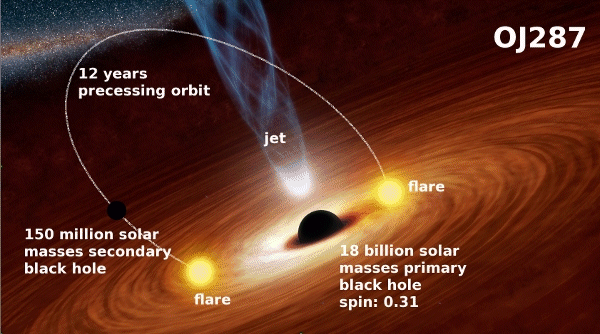2020 April 29
News of the binary black hole, OJ287

Point your telescope to a small patch of sky 3.5 degrees east of the open cluster M44 (The Beehive Cluster) in Cancer, and you will come across one of the most amazing objects visible in the entire sky – the binary black hole OJ287.
Usually seen shining as a point source of light around magnitude 14.0-15.0, the system contains a supermassive black hole (BH) of 18 billion solar masses being orbited by a ‘smaller’ BH of a mere 150 solar masses. Twice during the orbit, the smaller BH impacts and crashes through the accretion disc of the larger, producing an increase in brightness in all wavelengths and the near certainty of gravitational waves emanating from the impact zone. These impact events occur in pairs varying from around twelve years to less than five, due to reletavistic effects and the precessing nature of the smaller BH around the primary.
Professional and amateur astronomers have been monitoring OJ287 for decades, and both visual and CCD observers of the BAA Variable Star Section have been collaborating with professional teams to monitor these disc impacts since the early 1990’s. Thanks to both professional and amateur data obtained over the past forty years, the times of impact of the smaller BH through the disc of the primary can now be predicted to within hours of the event. It is though essential that each disc impact is observed in order to refine the predictions of future events.
The last disc event to occur provided astronomers with a massive problem however, as it was predicted to impact in July 2019, a time when the Sun lies in the constellation of Cancer thus making the whole event invisible to ground based observers. Not to be outdone, time on the Spitzer Space Telescope was obtained to monitor the July event from space – Spitzer being the only space-based telescope which could observe the field of OJ287 so close to the Sun. The operation was a success, and data was obtained by Spitzer of the 2019 disc event.
The results of the Spitzer observing run have now been published, and are available to download from Cornell University arXiv webpages… Spitzer Observations of the Predicted Eddington Flare from Blazar OJ 287. Laine et al
The BBC is also running an article on Spitzer and OJ287 on its ‘Science & Environment’ news page.
Finder charts for OJ287 can be downloaded from the BAAVSS web page.
BAA Variable Star Section
Image credits:
Spitzer:NASA/JPL-Caltech
OJ diagram: Stanislaw Zola
| The British Astronomical Association supports amateur astronomers around the UK and the rest of the world. Find out more about the BAA or join us. |
